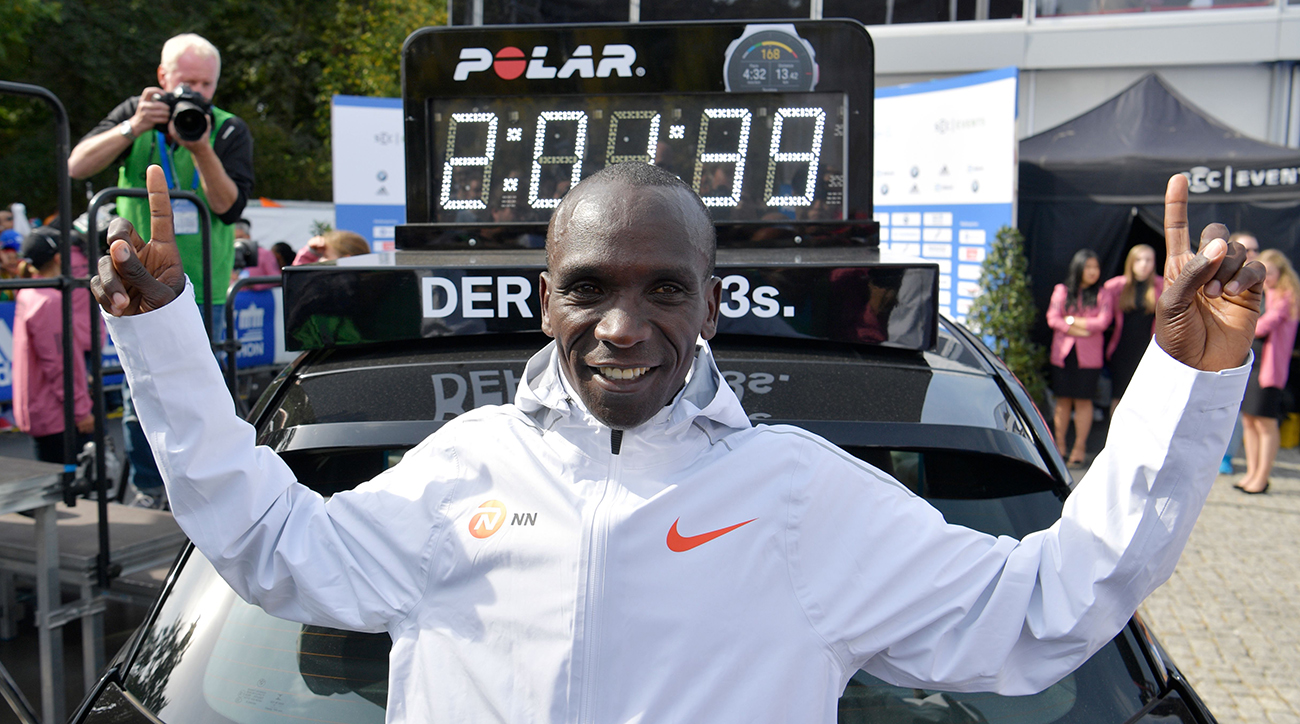After Eliud Kipchoge’s New World Record, How Close Are We to the Two-Hour Marathon?
A version of this story appears in the Oct. 8, 2018, issue of Sports Illustrated. For more great storytelling and in-depth analysis, subscribe to the magazine—and get up to 94% off the cover price. Click here for more.
When Eliud Kipchoge crossed the finish line of the Berlin Marathon in 2:01:39 last month, he didn't just beat the world record—he smashed it by 78 seconds, the largest improvement over the previous record since 1967. After that stunning achievement, it's time to consider whether the once unthinkable is possible: Will a marathoner break the two-hour barrier?
After Berlin, 99 seconds separate the world record from the two-hour mark. While there are still plenty of skeptics, in a 1991 paper Dr. Michael Joyner, a physiologist at the Mayo Clinic, argued that a 1:57:58 marathon was theoretically possible for an ideal runner, for instance someone with a high level of maximum oxygen consumption. Last year Nike organized an attempt to break two hours in a controlled environment—nearly perfect weather conditions, an alternating cast of pacers and special shoes supposedly engineered to offer a 4% benefit in running economy—and Kipchoge came up short, running 2:00:25 on a flat Formula 1 course in Italy. (The attempt wasn't eligible for the official world record.)
Kipchoge, 33, has won 11 of 12 career marathons, and it's likely his mark will stand for the foreseeable future. "I think Kipchoge is the greatest we've seen, and I think [his record is] going to be hard to beat," says Alex Hutchinson, the author of Endure: Mind, Body, and the Curiously Elastic Limits of Human Performance. "But I also think that whatever someone does, sooner or later someone else comes along who can do it better."
In other words, as Hutchinson argues in his book, endurance is as much an exercise in mental drive as it is in physical capacity. So as the record inches closer to two hours, reaching that milestone becomes increasingly attainable. Joyner, for one, is bullish. "If I was in Vegas," he says, "I'd put the over/under at 2028 or 2029."
With all of the talk about the advancement of shoe technology, fueling, course design and pacing strategy, I posed the question to Hutchinson and Joyner as to whether we’re heading into an era of gear controversy in the sport. Swimming faced its moment when full body swimsuits resulted in an unprecedented number of world records being shattered in from 2008 until they were banned in 2010. Here’s how they responded:
Hutchinson: I think it’s a possibility. That could be the case. The fact that Kipchoge has now run this fast makes it all that much harder to press on the brakes.
If there was going to be a time to regulate those shoes, it was probably last year. There’s a chance that the shoes could be a big deal but we just don’t know. It’s not clear what the real world effects of the shoes are. One point that I’ll make is that I don’t think the advantage from the shoes is as unprecedented as some people are arguing.
If you look at the history of the marathon, there’s been lot of changes to the way people run races. It used to be that you weren’t allowed to take fluids in the first 10K of the race. We’re now complaining about that now and saying that every marathon time set since the ’70s is invalid because people are now drinking during marathons.
The fact that people have been getting faster over the past century has always been tied up with the evolution of technology and circumstances during the race. The analogy to the swimsuit controversy says that we have to accept a little bit of technological evolution into the sport but if it gets totally out of hand then it makes a mockery of the sport. Is this going to happen in running where we’re going to have random unknown guys running 2:05 in Buenos Aires in the heat? Oh wait. That just happened.
My sense is that if the shoes on their own were so wild or so powerful, we’d see more people running if not 2:01 then 2:03. There’s a lot of people around the world who have been wearing these shoes and Kipchoge is head and shoulders, like minutes, ahead of the greatest runners in the world. With the swimsuits, everyone was swimming fast. That argues to me that the shoes maybe aren’t quite as big of a deal as they seem. We’ll see.
Joyner: I imagine that we’re going to see various competitors to these Nike shoes come out pretty soon. What Breaking2 and Kipchoge’s recent performance proved was that perhaps the shoes could be worth about a minute. It could be a little more or a little less. What I think it showed more was the power of the pacing. In both cases, the weather was a little warmer than optimal. I’m a little skeptical about the drink but I wouldn’t rule it out. I’ve always thought that if you gave Kipchoge some sweetened iced tea then he’d do fine.
If we go back and Google “Puma brush spikes”—in 1968, Puma came out with an innovative brush spike that was banned. There were all sorts of reasons for it. One was that people thought it gave an unfair advantage. Others thought that Puma and Adidas were in a shoe war and Adidas may or may not have bribed getting those banned. There’s a collection of urban legends around the shoes. Do you regulate shoes? I don’t know. If Bill Bowerman tinkers with shoes in his garage to make your kicks lighter than mine, is that illegal? What’s the difference between a big company doing that and marketing it? Where you draw the line on equipment can get murky. Sometimes you just say that minor tweaks in equipment happen.





